Entry tags:
The Soseono Masterpost
"Sole reining queen and foundress in Korean history, she it was who built the two ancient kingdoms of Goguryeo and Baekje."
- Shin Chaeho, Ancient Korean History
Soseono (pronounced so-suh-no. 소서노 [召西奴]; 66 B.C.- 6 B.C.) was a part of the founding of two kingdoms in ancient Korea, Goguryeo and Baekje. She was the queen of the first king of Goguryeo and the mother of the first king of Baekje, but according to some she was far more than a wife and mother of founders but a founder and even ruling queen in her own right. The purpose of this post is to reconstruct the life of this remarkable woman based on reliable historical information.
* For a pronunciation guide and a note on the names see Korean Romanization and Notes on Ancient Names.
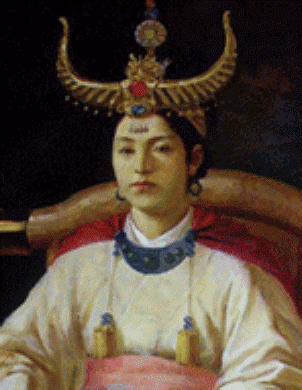
Artist's rendering
Korea and Northeast China, First Century B.C.
These are the very broad strokes of the political situation of the Koreanic peoples when Soseono was born. The last vestiges of the ancient Korean kingdom Joseon* (조선 [朝鮮], also commonly spelled Choson, Choseon) had fallen in the year 108 B.C, forty years before Soseono was born. The peoples who would later be called Koreans lived on the Korean peninsula and northeast China in tribes and tribal coalitions.
* Ancient Joseon is now commonly called Gojoseon or Old Joseon (고조선 [古朝鮮]) to disambiguate from the later Korean kingdom of Joseon, 1392-1897.
The major Koreanic political entity at this time was Buyeo (부여 [扶餘]), founded sometime in the second century B.C. by the Yemaek (예맥 [濊貊]) who were one of the ancient branches of the Koreanic peoples. Buyeo's territory covered much of what is now Manchuria, centering around the modern-day Songhua River and reaching west to Liaoning and north to the Amur (Helong River). Its political influence reached as far as the area now called Primorsky Krai. Buyeo is also called North Buyeo in the records I present below.
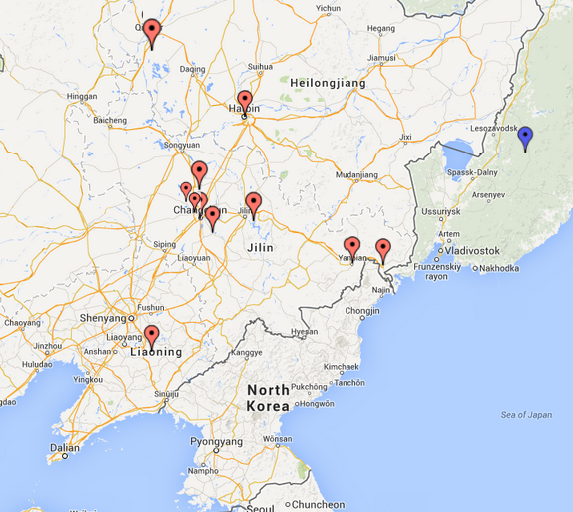
Areas under Buyeo control (red) and influence (blue)
There were also other Koreanic polities on the Korean peninsula proper, mostly in the form of tribes and tribal alliances that were not as centralized as Buyeo or the bygone Joseon. Parts of the northern peninsula were taken over by Chinese settlements and nomadic raiders, and the south was divided between the decentralized alliances of Mahan, Dongye, Jinhan, and Byeonhan.
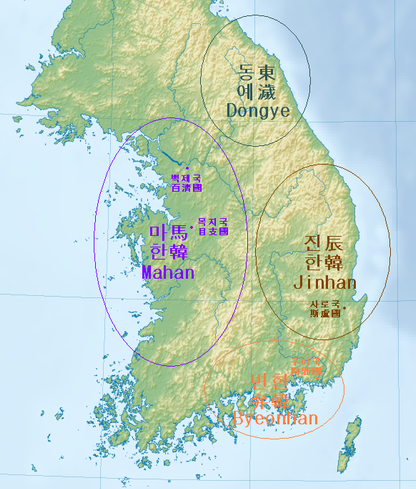
The Three Hans, or Samhan
Conflicting Records
The Samguk Sagi* lists two different accounts of the founding of Goguryeo and Baekje. The details of Soseono's life change depending on the record. I will present them in the same order as the Sagi did, then comment on them and attempt to construct Soseono's life from the records.
* 삼국사기 [三國史記], "Record of the History of the Three Kingdoms." A history, completed in 1145 A.D., of the three ancient kingdoms of Goguryeo, Baekje, and Shilla
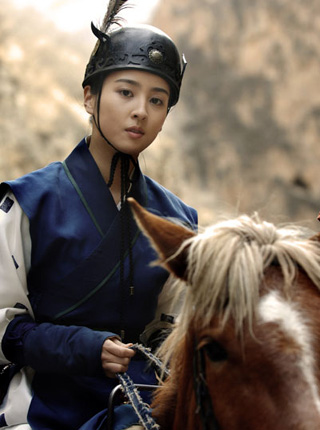
Han Hyejin as Soseono
(from the 2006 MBC drama Jumong)
Here is the first account, which is often called the "Onjo theory" because it states that Soseono's younger son Onjo was the founding king of Baekje. I'll focus on what it says about Soseono and call this the "second princess account."
You can see why I call this the second princess account: Chumo's new wife is not mentioned here other than as the second daughter of the king of Jolbon Buyeo.

From Jumong (2006)
Here's the other, conflicting account, often called the "Biryu theory" because it implies Soseono's elder son Biryu was the founding king of Baekje. I'll call this the "Yeontabal's daughter account."
This account not only names Soseono, an unusual occurrence in itself for women in ancient Asian history, but assigns her an active role in the founding of Goguryeo and goes into detail about her life. This is the record that gave rise to much of the speculation and hero-worship of the woman.
Ironically, the account that is accepted as historical fact is the first one, the one that calls Onjo the founding king and does not name Chumo's second wife. It also has some irreconcilable differences from the daughter of Yeontabal account, especially toward the end. I'll discuss these discrepancies below, though a full discussion of the Onjo-Biryu divide is beyond the scope of this article.
Birth and Family
Soseono was born in the year 66 B.C., something we know because her year and age of death are recorded, as discussed below. Jolbon (also recorded as Holbon), the place of her birth, was likely in the area of modern-day Huanren Manchu Autonomous County in Liaoning.
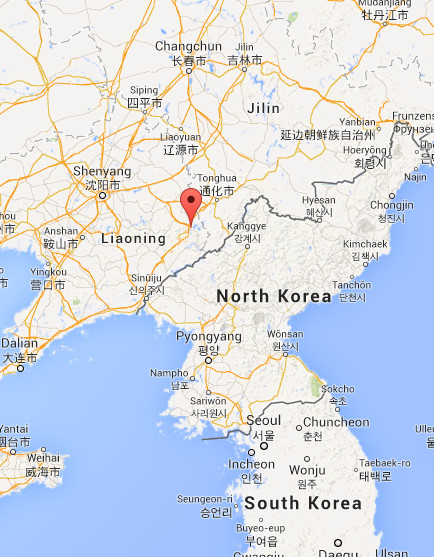
Location of Jolbon
The relationship between the region of Jolbon/Holbon and the kingdom of Buyeo is not clear. Jolbon was at the southwestern edge of Buyeo influence, and may have been a part of it. At any rate, the name Jolbon Buyeo seems to intimate a connection with Buyeo, an appearance that was encouraged by the rulers of Goguryeo and later Baekje. The name "North Buyeo" for Jumong/Chumo's old country may have been an extension of this effort, to give the impression that Jolbon was some kind of "South" Buyeo or was even Buyeo proper. The latter is highly unlikely from what we know of Buyeo.
From the historical record it's indisputable that Goguryeo and Baekje were founded in part by groups from Buyeo or North Buyeo. The only uncertainty is whether the original settlers of Jolbon, Soseono's people, were Yemaek people of Buyeo. They certainly formed marriage and political alliances with Buyeo groups, if Soseono's marriages were any indication, but that's as far as modern knowledge goes.
Depending on the account you go by, Soseono's father was either the king of Jolbon or a man called Yeontabal who lived in Jolbon. So she was either a princess or the daughter of a man who presumably had some means and influence in the area, since she had wealth enough to found a kingdom as his daughter. Some say he was a chieftain in one of the five tribes that would eventually form Goguryeo.
Personally I don't think the accounts are necessarily conflicting; the distinction between king, chieftain, and rich man was likely far from clear 2,000 years ago. So let's say she was the daughter, probably the second out of three, of an influential man in the Jolbon area and that he was probably named Yeontabal.
First Marriage

From Jumong (2006)
As seen above, "Soseono" is nameless in the record that calls her the second daughter of the king of Jolbon, nor is there a mention there of her marrying anyone but Jumong. We only guess that this princess is the same person as Soseono because of her marriage.
According to the record that calls her the daughter of Yeontabal, Soseono first married Utae, an illegitimate grandson of Haeburu king of Buyeo, and had two sons with him, Biryu and Onjo. In this version of events her clan's ties to Buyeo groups and the Buyeo royal family are even more extensive than in the first account, with both Soseono's marriages being with men from the Buyeo royal line.
Marriage to Chumo
Jumong, or Chumo (58~19 B.C.), was a foster-son or stepson of King Geumwa of (North) Buyeo. Jumong has a long, strange history of his own that I won't go into here. I'll use the name Chumo for him since it's the version most often used by Goguryeo records and is thought to be closest to the original pronunciation. Chumo fled from Buyeo under threat to his life from Daeso, the eldest son of Geumwa, leaving behind his wife Lady Yeh and their unborn child.
Chumo came south to Jolbon/Holbon, and depending on the record you believe married the second daughter of the king of Jolbon or Soseono daughter of Yeontabal. There are a couple of other accounts of whom he married at this point, such as the woman from Wolgun mentioned above. These might all be Soseono, or they may all be different women, or the others might not have existed. Certainly it wouldn't be impossible that Chumo married multiple women from prominent families as he consolidated power, but accounts of these other marriages are fragmentary and confusing enough that no one gives them much credence. The only ones we're sure about are his marriage to the woman from the house of Yeh and to Soseono.
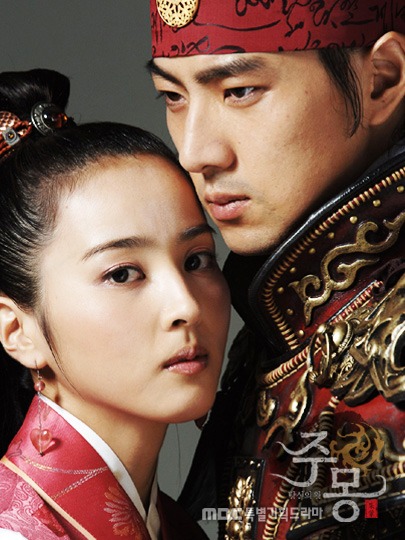
With Song Ilguk as Jumong in Jumong (2006)
The records also differ on the paternity of Soseono's sons Biryu and Onjo. In the second-princess-of-Jolbon record Biryu and Onjo are the sons of Chumo. If you go by the Soseono-daughter-of-Yeontabal record they were the sons of Utae, Soseono's first husband. These might not be as irreconcilable as at first sight, as we will see below.
The Founding of Goguryeo
In the year 37 B.C. the kingdom of Goguryeo was founded. Soseono would have been twenty-nine years old at this time, and Chumo twenty-two. This is one reason historians tend to give weight to the daughter-of-Yeontabal record that states she was a widow, since it strains suspension of disbelief that a woman in her late twenties was unmarried in the first century B.C.
In the second-princess-of-Jolbon record, Chumo inherited his father-in-law's kingdom because the king of Jolbon had no sons. Under the Soseono-daughter-of-Yeontabal record, this founding was due in great part to the wealth and power of Yeontabal's house and Soseono's support in addition to Chumo's considerable leadership and martial prowess.
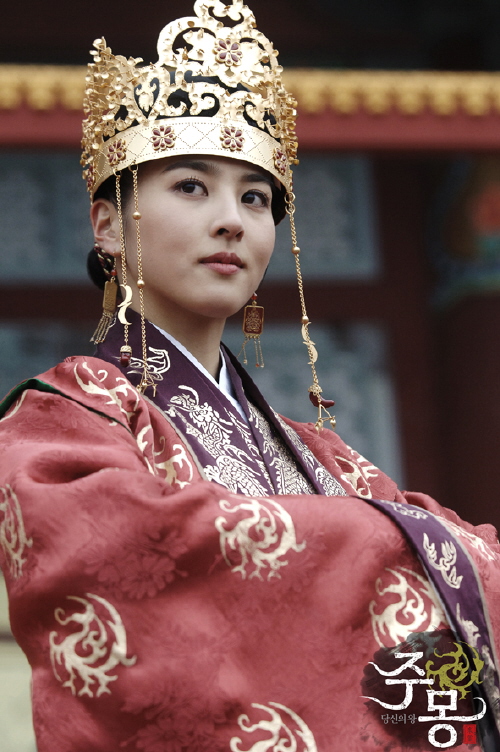
From Jumong (2006)
No matter which record you believe, though, two things are clear: First, Chumo was able to found his kingdom due to the influence and power of his second wife and her house. Second, he greatly expanded the power and territory of whatever kingdom or tribe he inherited through a series of conquests.
The accounts of the brothers Biryu and Onjo's paternity can similarly be reconciled if we recall the story of Soseono and Chumo's marriage in the daughter-of-Yeontabal record: Chumo greatly loved and respected his wife for her enormous help in founding the kingdom, and also loved her sons as his own. It wouldn't be a stretch under these circumstances to call Chumo the father of Soseono's sons, particularly the younger son Onjo's since Chumo might well have been the only father Onjo knew. Beyond personal relationships, this record of Chumo as Onjo's father may have worked to strengthen Baekje's ties to Goguryeo.
That affection only went so far, however, because everything was to change when Chumo's first son came along.
Fallout and the Founding of Baekje
In the year 19 B.C., almost twenty years after the founding of Goguryeo, Chumo's now-grown son Yuryu (or Yuri) escaped Buyeo and came to Goguryeo. The records agree that Jumong raised Yuri to the position of crown prince. This change of heart is a major reason historians believe Biryu and Onjo were Chumo's stepsons rather than sons. Chumo would die soon after at the age of forty, a mere five months after naming Yuri his heir.
Biryu and Onjo, fearing for their lives now that they had lost out on the dynastic struggle, went south with their mother and their people to found a new country, settling in the northern reaches of Mahan territory. This was the second of the ancient Korean kingdoms, Baekje.
Yet again we are plagued by conflicting accounts of what happened when Soseono and her sons went south to the peninsula. Under the second-princess record, there was a split between the brothers and Biryu went to Michuhol while Onjo went to Wiryeh, which was possibly south of the Han river in Seoul. In this version of events Michuhol failed as a capital because of the swampy land and salty water. Biryu killed himself out of shame, leaving Onjo the sole king.
In the account that names Soseono daughter of Yeontabal, the elder son Biryu founded his new kingdom at Michuhol which is thought to be in modern-day Incheon, and became the founding king.
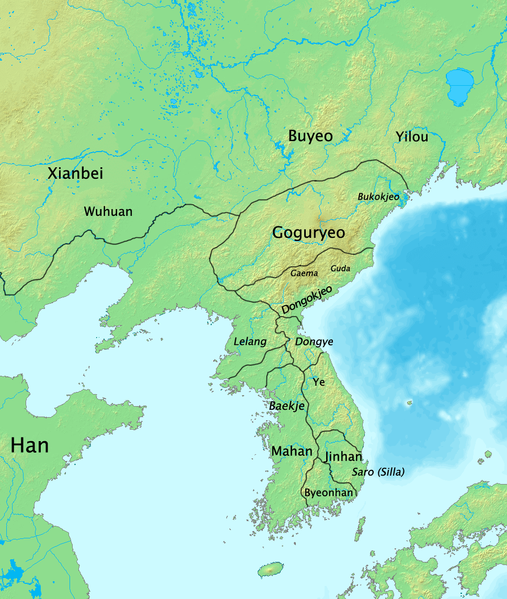
Political map after the founding of Goguryeo and Baekje
One notices certain trends in contrasting these two accounts. The second-princess account, the one that supports the theory that Onjo was the founding king, tends to discount Soseono and Biryu's roles and emphasize the roles of Onjo and his ten lords. The Soseono-daughter-of-Yeontabal account, the one that names Biryu the founding king, depicts Soseono and Biryu as the main players. This seems to point to a strife between the founding forces of Baekje, with Soseono and Biryu being erased from the history of the founding to legitimize Onjo as king. Besides, Biryu's death in the first version of events doesn't sound like a natural progression. The suicide of a major royal contender seems to follow from losing out in an internal power struggle, not literal death by embarrassment.
Some believe these conflicting accounts imply a hidden truth about the founding of Baekje--that Soseono, not Onjo or Biryu, was the true founding monarch of Baekje. The early twentieth-century historian Shin Chaeho, quoted at the start of this essay, argued that the Michuhol-Wiryeh split happened after Soseono's death when the kingdom fell to squabbling pieces after the death of the founder.
Another historian, Seong Yulja, followed the accepted history in thinking that the split happened in Soseono's lifetime, but believed this was evidence of Soseono's central role. If the fledgling country was split between two centers of power, she reasoned, they would have needed a control tower to mediate between the two. This, Seong reasoned, must have been Soseono, who was well-suited to the role due to her ties to both factions as the mother of the leaders and her experience and ability as the founder of a kingdom.
Whatever the truth of Soseono's role it must have been considerable, since her death was recorded to be a major blow to the newly-formed kingdom.

Jeong Aeri as Soseono in the 2010 KBS drama Geunchogo-wang
Death and Aftermath
Soseono's death is recorded in this strange passage:
Shin Chaeho argued that this was a veiled reference to Soseono's role and the resulting regime change. Since sensitive political events were given only veiled metaphorical references in ancient times, the old woman becoming a man referred to the old queen being replaced by a new king; that is, Soseono was the reining queen until Onjo replaced her. Shin also said the five tigers referred to a coup d'état, possibly the assassination of Soseono. Seong Yulja and others say the sex-change passage means Soseono died in armor like a man, likely during the political turmoil that the five tigers refer to.
Whether she was reining queen or not, Soseono's death was traumatic enough that it was an occasion for sweeping change. The historical record goes on to say:
In other words, Soseono's death was right up there with enemy invasions and bad omens when it came to the decision to change the capital of the country. Assuming her death was the result of a political upheaval, as seems likely, it would stand to reason Onjo would want a change of air.

Baekje royalty give rites before Soseono's suit of armor in Geunchogo-wang (2010)
Conclusion
This is what we know of the woman, from a few and conflicting lines in an ancient text. These few lines, however, have sparked innumerable books, articles, scholarly arguments, and works of fiction. She has set fire to our imagination for thousands of years, and her story says or hints at so much about history and the people who wrote them--about politics and power, men and women, the things said and unsaid as history is shaped to fit agendas.
Obviously we'll never know the real facts of Soseono's life. It was too long ago, and too much has been lost. What we have is a lot of guessing, educated and otherwise. This is all that is left, and we make what we can of it. Perhaps what we make of her story says more about us than about the woman who lived 2,000 years ago.
- Shin Chaeho, Ancient Korean History
Soseono (pronounced so-suh-no. 소서노 [召西奴]; 66 B.C.- 6 B.C.) was a part of the founding of two kingdoms in ancient Korea, Goguryeo and Baekje. She was the queen of the first king of Goguryeo and the mother of the first king of Baekje, but according to some she was far more than a wife and mother of founders but a founder and even ruling queen in her own right. The purpose of this post is to reconstruct the life of this remarkable woman based on reliable historical information.
* For a pronunciation guide and a note on the names see Korean Romanization and Notes on Ancient Names.

Artist's rendering
Korea and Northeast China, First Century B.C.
These are the very broad strokes of the political situation of the Koreanic peoples when Soseono was born. The last vestiges of the ancient Korean kingdom Joseon* (조선 [朝鮮], also commonly spelled Choson, Choseon) had fallen in the year 108 B.C, forty years before Soseono was born. The peoples who would later be called Koreans lived on the Korean peninsula and northeast China in tribes and tribal coalitions.
* Ancient Joseon is now commonly called Gojoseon or Old Joseon (고조선 [古朝鮮]) to disambiguate from the later Korean kingdom of Joseon, 1392-1897.
The major Koreanic political entity at this time was Buyeo (부여 [扶餘]), founded sometime in the second century B.C. by the Yemaek (예맥 [濊貊]) who were one of the ancient branches of the Koreanic peoples. Buyeo's territory covered much of what is now Manchuria, centering around the modern-day Songhua River and reaching west to Liaoning and north to the Amur (Helong River). Its political influence reached as far as the area now called Primorsky Krai. Buyeo is also called North Buyeo in the records I present below.

Areas under Buyeo control (red) and influence (blue)
There were also other Koreanic polities on the Korean peninsula proper, mostly in the form of tribes and tribal alliances that were not as centralized as Buyeo or the bygone Joseon. Parts of the northern peninsula were taken over by Chinese settlements and nomadic raiders, and the south was divided between the decentralized alliances of Mahan, Dongye, Jinhan, and Byeonhan.

The Three Hans, or Samhan
Conflicting Records
The Samguk Sagi* lists two different accounts of the founding of Goguryeo and Baekje. The details of Soseono's life change depending on the record. I will present them in the same order as the Sagi did, then comment on them and attempt to construct Soseono's life from the records.
* 삼국사기 [三國史記], "Record of the History of the Three Kingdoms." A history, completed in 1145 A.D., of the three ancient kingdoms of Goguryeo, Baekje, and Shilla

Han Hyejin as Soseono
(from the 2006 MBC drama Jumong)
Here is the first account, which is often called the "Onjo theory" because it states that Soseono's younger son Onjo was the founding king of Baekje. I'll focus on what it says about Soseono and call this the "second princess account."
The founder of Baekje was King Onjo. His father was Chumo, also called Jumong. Jumong fled strife in his native North Buyeo and reached the land of Jolbon Buyeo. The king of Buyeo [meaning Jolbon Buyeo] had no sons and three daughters. He recognized Jumong's extraordinary qualities and gave his second daughter to the young man to wed. The king passed away not long after, and Jumong inherited the throne. It was also said that Jumong came to Jolbon, married a woman in Wolgun and had two sons with her.
When Yuryu, Jumong's son from North Buyeo, came and was named crown prince, Biryu and Onjo feared that the new crown prince would turn against them and went south with ten lords including Ogan and Maryeoh, with many of the people following. [Summary of remaining parts: Biryu went to Michuhol by the sea to set up his capital, while Onjo stayed at Wiryeh south of the river with the ten lords. Biryu's capital failed due to the swampy ground and salty water, while Onjo's prospered. Biryu killed himself out of shame and his followers accepted Onjo as king.]
You can see why I call this the second princess account: Chumo's new wife is not mentioned here other than as the second daughter of the king of Jolbon Buyeo.

From Jumong (2006)
Here's the other, conflicting account, often called the "Biryu theory" because it implies Soseono's elder son Biryu was the founding king of Baekje. I'll call this the "Yeontabal's daughter account."
It was also said that the founder of Baekje was King Biryu. His father was Utae, an illegitimate grandson of Haeburu, king of North Buyeo. His mother was Soseono, daughter to Yeontabal of Jolbon. Soseono originally married Utae and had two sons, the first of whom was Biryu and the second Onjo.
When Utae died, Soseono lived as a widow in Jolbon. Later, when Jumong was ejected from Buyeo, he fled south in the spring of [the year 37 B.C.] in the second month and came to Jolbon, where he built his capital and named his new country Goguryeo. He married Soseono and she became his queen. Jumong was extraordinarily affectionate and generous with her because of her enormous help in the founding, and treated Biryu and his brother as his own sons.
Then Yuryu, the son Jumong had with the lady from the house of Yeh back in Buyeo, came to Jolbon. Jumong named him crown prince and Yuryu came to inherit the throne. Therefore Biryu said to his brother Onjo:
"When the Great King first fled here from the strife in Buyeo our mother went to much toil and effort, spending the wealth of her house so he could found this kingdom. Now that the king has passed away and the country belongs to Yuryu, rather than stay here unwanted and stifled it is better that we go south with Mother and raise a new capital in a place of our choosing."
Finally Biryu together with his brother led a multitude and crossed the two rivers of the Paesu and Daesu to settle at Michuhol.
This account not only names Soseono, an unusual occurrence in itself for women in ancient Asian history, but assigns her an active role in the founding of Goguryeo and goes into detail about her life. This is the record that gave rise to much of the speculation and hero-worship of the woman.
Ironically, the account that is accepted as historical fact is the first one, the one that calls Onjo the founding king and does not name Chumo's second wife. It also has some irreconcilable differences from the daughter of Yeontabal account, especially toward the end. I'll discuss these discrepancies below, though a full discussion of the Onjo-Biryu divide is beyond the scope of this article.
Birth and Family
Soseono was born in the year 66 B.C., something we know because her year and age of death are recorded, as discussed below. Jolbon (also recorded as Holbon), the place of her birth, was likely in the area of modern-day Huanren Manchu Autonomous County in Liaoning.

Location of Jolbon
The relationship between the region of Jolbon/Holbon and the kingdom of Buyeo is not clear. Jolbon was at the southwestern edge of Buyeo influence, and may have been a part of it. At any rate, the name Jolbon Buyeo seems to intimate a connection with Buyeo, an appearance that was encouraged by the rulers of Goguryeo and later Baekje. The name "North Buyeo" for Jumong/Chumo's old country may have been an extension of this effort, to give the impression that Jolbon was some kind of "South" Buyeo or was even Buyeo proper. The latter is highly unlikely from what we know of Buyeo.
From the historical record it's indisputable that Goguryeo and Baekje were founded in part by groups from Buyeo or North Buyeo. The only uncertainty is whether the original settlers of Jolbon, Soseono's people, were Yemaek people of Buyeo. They certainly formed marriage and political alliances with Buyeo groups, if Soseono's marriages were any indication, but that's as far as modern knowledge goes.
Depending on the account you go by, Soseono's father was either the king of Jolbon or a man called Yeontabal who lived in Jolbon. So she was either a princess or the daughter of a man who presumably had some means and influence in the area, since she had wealth enough to found a kingdom as his daughter. Some say he was a chieftain in one of the five tribes that would eventually form Goguryeo.
Personally I don't think the accounts are necessarily conflicting; the distinction between king, chieftain, and rich man was likely far from clear 2,000 years ago. So let's say she was the daughter, probably the second out of three, of an influential man in the Jolbon area and that he was probably named Yeontabal.
First Marriage

From Jumong (2006)
As seen above, "Soseono" is nameless in the record that calls her the second daughter of the king of Jolbon, nor is there a mention there of her marrying anyone but Jumong. We only guess that this princess is the same person as Soseono because of her marriage.
According to the record that calls her the daughter of Yeontabal, Soseono first married Utae, an illegitimate grandson of Haeburu king of Buyeo, and had two sons with him, Biryu and Onjo. In this version of events her clan's ties to Buyeo groups and the Buyeo royal family are even more extensive than in the first account, with both Soseono's marriages being with men from the Buyeo royal line.
Marriage to Chumo
Jumong, or Chumo (58~19 B.C.), was a foster-son or stepson of King Geumwa of (North) Buyeo. Jumong has a long, strange history of his own that I won't go into here. I'll use the name Chumo for him since it's the version most often used by Goguryeo records and is thought to be closest to the original pronunciation. Chumo fled from Buyeo under threat to his life from Daeso, the eldest son of Geumwa, leaving behind his wife Lady Yeh and their unborn child.
Chumo came south to Jolbon/Holbon, and depending on the record you believe married the second daughter of the king of Jolbon or Soseono daughter of Yeontabal. There are a couple of other accounts of whom he married at this point, such as the woman from Wolgun mentioned above. These might all be Soseono, or they may all be different women, or the others might not have existed. Certainly it wouldn't be impossible that Chumo married multiple women from prominent families as he consolidated power, but accounts of these other marriages are fragmentary and confusing enough that no one gives them much credence. The only ones we're sure about are his marriage to the woman from the house of Yeh and to Soseono.

With Song Ilguk as Jumong in Jumong (2006)
The records also differ on the paternity of Soseono's sons Biryu and Onjo. In the second-princess-of-Jolbon record Biryu and Onjo are the sons of Chumo. If you go by the Soseono-daughter-of-Yeontabal record they were the sons of Utae, Soseono's first husband. These might not be as irreconcilable as at first sight, as we will see below.
The Founding of Goguryeo
In the year 37 B.C. the kingdom of Goguryeo was founded. Soseono would have been twenty-nine years old at this time, and Chumo twenty-two. This is one reason historians tend to give weight to the daughter-of-Yeontabal record that states she was a widow, since it strains suspension of disbelief that a woman in her late twenties was unmarried in the first century B.C.
In the second-princess-of-Jolbon record, Chumo inherited his father-in-law's kingdom because the king of Jolbon had no sons. Under the Soseono-daughter-of-Yeontabal record, this founding was due in great part to the wealth and power of Yeontabal's house and Soseono's support in addition to Chumo's considerable leadership and martial prowess.

From Jumong (2006)
No matter which record you believe, though, two things are clear: First, Chumo was able to found his kingdom due to the influence and power of his second wife and her house. Second, he greatly expanded the power and territory of whatever kingdom or tribe he inherited through a series of conquests.
The accounts of the brothers Biryu and Onjo's paternity can similarly be reconciled if we recall the story of Soseono and Chumo's marriage in the daughter-of-Yeontabal record: Chumo greatly loved and respected his wife for her enormous help in founding the kingdom, and also loved her sons as his own. It wouldn't be a stretch under these circumstances to call Chumo the father of Soseono's sons, particularly the younger son Onjo's since Chumo might well have been the only father Onjo knew. Beyond personal relationships, this record of Chumo as Onjo's father may have worked to strengthen Baekje's ties to Goguryeo.
That affection only went so far, however, because everything was to change when Chumo's first son came along.
Fallout and the Founding of Baekje
In the year 19 B.C., almost twenty years after the founding of Goguryeo, Chumo's now-grown son Yuryu (or Yuri) escaped Buyeo and came to Goguryeo. The records agree that Jumong raised Yuri to the position of crown prince. This change of heart is a major reason historians believe Biryu and Onjo were Chumo's stepsons rather than sons. Chumo would die soon after at the age of forty, a mere five months after naming Yuri his heir.
Biryu and Onjo, fearing for their lives now that they had lost out on the dynastic struggle, went south with their mother and their people to found a new country, settling in the northern reaches of Mahan territory. This was the second of the ancient Korean kingdoms, Baekje.
Yet again we are plagued by conflicting accounts of what happened when Soseono and her sons went south to the peninsula. Under the second-princess record, there was a split between the brothers and Biryu went to Michuhol while Onjo went to Wiryeh, which was possibly south of the Han river in Seoul. In this version of events Michuhol failed as a capital because of the swampy land and salty water. Biryu killed himself out of shame, leaving Onjo the sole king.
In the account that names Soseono daughter of Yeontabal, the elder son Biryu founded his new kingdom at Michuhol which is thought to be in modern-day Incheon, and became the founding king.

Political map after the founding of Goguryeo and Baekje
One notices certain trends in contrasting these two accounts. The second-princess account, the one that supports the theory that Onjo was the founding king, tends to discount Soseono and Biryu's roles and emphasize the roles of Onjo and his ten lords. The Soseono-daughter-of-Yeontabal account, the one that names Biryu the founding king, depicts Soseono and Biryu as the main players. This seems to point to a strife between the founding forces of Baekje, with Soseono and Biryu being erased from the history of the founding to legitimize Onjo as king. Besides, Biryu's death in the first version of events doesn't sound like a natural progression. The suicide of a major royal contender seems to follow from losing out in an internal power struggle, not literal death by embarrassment.
Some believe these conflicting accounts imply a hidden truth about the founding of Baekje--that Soseono, not Onjo or Biryu, was the true founding monarch of Baekje. The early twentieth-century historian Shin Chaeho, quoted at the start of this essay, argued that the Michuhol-Wiryeh split happened after Soseono's death when the kingdom fell to squabbling pieces after the death of the founder.
Another historian, Seong Yulja, followed the accepted history in thinking that the split happened in Soseono's lifetime, but believed this was evidence of Soseono's central role. If the fledgling country was split between two centers of power, she reasoned, they would have needed a control tower to mediate between the two. This, Seong reasoned, must have been Soseono, who was well-suited to the role due to her ties to both factions as the mother of the leaders and her experience and ability as the founder of a kingdom.
Whatever the truth of Soseono's role it must have been considerable, since her death was recorded to be a major blow to the newly-formed kingdom.

Jeong Aeri as Soseono in the 2010 KBS drama Geunchogo-wang
Death and Aftermath
Soseono's death is recorded in this strange passage:
In spring of the thirteenth year [of Onjo's rein; 6 B.C.] in the second month, an old woman morphed into a man in the capital and five tigers entered its walls. The king's mother died at the age of sixty-one.
Shin Chaeho argued that this was a veiled reference to Soseono's role and the resulting regime change. Since sensitive political events were given only veiled metaphorical references in ancient times, the old woman becoming a man referred to the old queen being replaced by a new king; that is, Soseono was the reining queen until Onjo replaced her. Shin also said the five tigers referred to a coup d'état, possibly the assassination of Soseono. Seong Yulja and others say the sex-change passage means Soseono died in armor like a man, likely during the political turmoil that the five tigers refer to.
Whether she was reining queen or not, Soseono's death was traumatic enough that it was an occasion for sweeping change. The historical record goes on to say:
In summer in the fifth month, the king said to his retainers, "We have enemies to the east and north invading our territory, giving us little peace. There are also frequent inauspicious signs and the mother of the nation has passed away, causing great unrest. We must therefore move the capital."
In other words, Soseono's death was right up there with enemy invasions and bad omens when it came to the decision to change the capital of the country. Assuming her death was the result of a political upheaval, as seems likely, it would stand to reason Onjo would want a change of air.

Baekje royalty give rites before Soseono's suit of armor in Geunchogo-wang (2010)
Conclusion
This is what we know of the woman, from a few and conflicting lines in an ancient text. These few lines, however, have sparked innumerable books, articles, scholarly arguments, and works of fiction. She has set fire to our imagination for thousands of years, and her story says or hints at so much about history and the people who wrote them--about politics and power, men and women, the things said and unsaid as history is shaped to fit agendas.
Obviously we'll never know the real facts of Soseono's life. It was too long ago, and too much has been lost. What we have is a lot of guessing, educated and otherwise. This is all that is left, and we make what we can of it. Perhaps what we make of her story says more about us than about the woman who lived 2,000 years ago.
